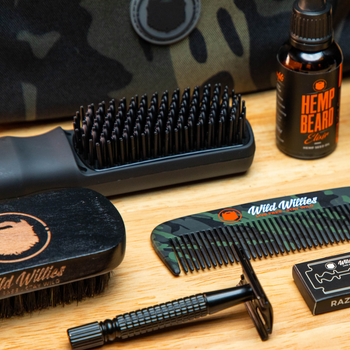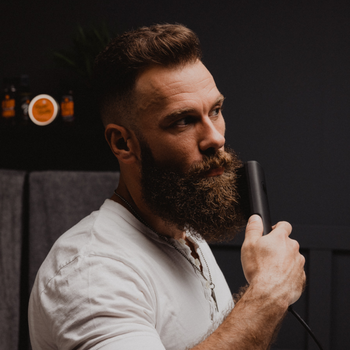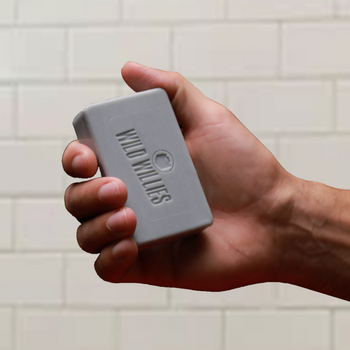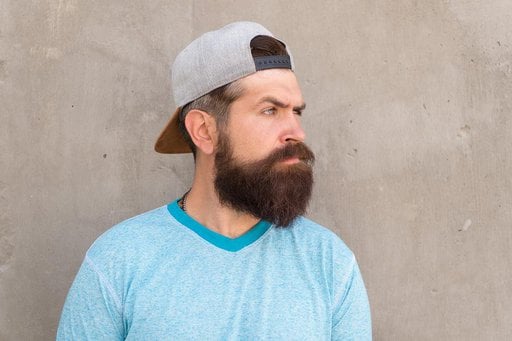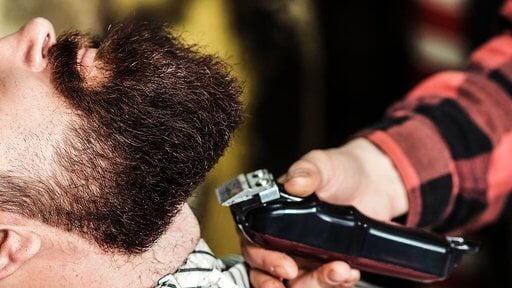One of the most common complaints voiced by men trying to grow a beard for the first time—or sometimes for the tenth time—is that their beard growth just isn’t consistent enough.
Their beard is too thick in some places, too thin in others, and sometimes nonexistent over whole sections of the face.
A patchy beard is something that many men have to deal with, and sadly it often discourages men from exploring the full potential of facial hair growth.
The good news is that just because your facial hair is inconsistent, patchy, or thin doesn’t mean that it’s impossible to grow an attractive beard.
The truth is that almost all men have at least some level of patchiness. After all, we’re people, and all of us have different factors determining how thickly and consistently our hair grows.
The trick to getting past the embarrassment and worry that comes with growing out a new beard is to have a strategy for dealing with normal beard growth problems.
Below are some of the most common patchy beard causes, and a few of the most effective solutions on how to fill in a patchy beard.
Common Patchy Beard Causes
1. Genetic Factors
We all learned the basics of this aspect of beard growth when we were teenagers…
In middle school and high school, we all knew kids who grew—or had to shave—a full beard whether they liked it or not, as well as kids who could barely grow a moustache if they tried.
Genetics are one of the biggest factors determining the thickness, length, and shape of our natural beards.
In fact, people are born with all of the hair follicles they’ll ever have.
As children, most of these follicles remain dormant, but as we hit puberty they begin to activate.
This may seem like bad news to people who have patchy beards. You may be feeling like growing a beard is impossible.
But this is actually good news. Some hair follicles can remain dormant late into life, but it’s always possible that they activate given time or the right stimulus.
2. Hormonal Imbalances
While hair follicles and genetics are a natural part of you, hormones change throughout your life and can actually have negative effects on beard growth, particularly if you suffer from imbalances.
The most influential hormone for facial hair growth in men is testosterone, and more specifically a subset of testosterone hormones known as dihydrotestosterone.
Dihydrotestosterone (or DHT) levels—and your body’s natural sensitivity to it—are big contributors to the fullness or patchiness of your beard.
If you’re wondering how to increase levels of helpful hormones like testosterone, look no further than the next point.
3. Poor Diet/Exercise Habits
Diet and exercise are critically important to your overall health and wellness, which in turn are crucial factors in the health of your head, facial and body hair.
In order to grow a healthy beard, you need to feed your beard the right nutrients to let it flourish.
The details of a healthy diet are best left for another blog post, but some of the most commonly referenced nutrients needed for healthy beard growth are protein, vitamins A, C and E, as well as omega-3 fatty acids, found in nuts and fish.
Exercise is important because it helps balance hormones and contribute to general wellbeing, but also because it’s a powerful tool in combating a common beard-killer: stress.
4. High Stress
We tend to see stress as a mental or emotional problem, but new research is revealing that the physical impact of stress can also be extremely detrimental to your physical health, including skin, muscle, and—you guessed it—facial hair.
Some studies have shown that stress increases the amount of a chemical called cortisol in our body, which causes decreased levels of DHT and other testosterone compounds.

Too much stress can also cause restricted blood flow in capillaries, which are basically the fuel lines that feed your hair follicles.
Finally, stress can lead to a number of other problems (such as skin problems like acne) that directly or indirectly affect facial hair growth.
Finding a rhythm in your daily routine that prevents you from encountering too much stress, as well as exercising on a regular basis, will help you feel better and grow a thicker, fuller beard.
5. Age
As we mentioned earlier, it might be discouraging for younger men to see others their age growing a full beard when they still aren’t able to.
But the hair follicles in the face are some of the very last to activate during the process of physical maturation, and some men don’t see full beard growth until their mid to late 20s.
25 is a commonly referenced age for maturity of the brain’s frontal lobe—the part involved in decision making and judgement skills—and coincidentally it also seems to be the age when most men see their beards reach maturity as well.
So if you’re a man in your late teens or early twenties worrying about the patchiness or overall thickness of your beard, getting a more luxurious beard might just mean being a little more patient.
But that doesn’t mean you can’t experiment with different styles and beard growth strategies in the meantime…
Even men who are never able to grow huge, bushy beards can have a great time growing moustaches, beardstaches, sideburns, goatees, and a number of other styles that don’t require absolute beard perfection.
The trick to doing this—and do solid beard growth in general—is to know how to groom the right way.
6. Grooming Mistakes
Growing an awesome beard isn’t just about having the right genetics and right diet…
Sometimes, the best solution is one of the simplest.
Simply knowing how to groom your beard is one of the best ways to make sure that it grows consistently across your face and doesn’t look, well… weird.
We’ll get into the details of good grooming later, but for now it’s important that you take note of the fact that what some people see as a natural problem with their beard is, in fact, a simple result of the fact that they never learned proper beard grooming etiquette.
7. Alopecia Areata
This is possibly the least common reason for beard patchiness, but it’s worth noting because it does occur in some men.
Alopecia areata is a baldness condition that can occur anywhere on the body, including the head and beard.
It results in dime-sized patches of baldness, and is caused by your immune system attacking your hair follicles.
As of yet there is no treatment for alopecia areata, nor are scientists sure exactly what causes it.
But as we mentioned earlier, there are always workarounds for those dedicated to having facial hair, so if you do suffer from alopecia areata, don’t despair!
Is It Impossible To Grow A Good Beard If You Have Patches?
Before we get to the best remedies for a patchy beard, it’s important to emphasize that you don’t need perfect genes to grow a manly beard.
In fact, a lot of famously handsome actors like Johnny Depp, Chris Pratt, and James Franco have relatively thin beards, but are able to pull them off with the right styling products, grooming tools, and just a touch of self-confidence.
But that’s not what we’re here to talk about, because most of the time it really is possible to grow a thicker, less patchy beard if you set your mind to it.
Here are some of the main ways that men have found to fill in those patches:
Best treatments and growth strategies for thin or patchy beards
1. Work On Your General Health
It’s easy to notice that a lot of people with patchy beard growth also tend to exhibit signs of general ill health, like a pale complexion, sunken eyes, and oily or dry hair on their head.
This is because the health of your body and the health of your beard are closely related.

We’ve mentioned healthy diet and exercise, but another important aspect of good overall health that’s often overlooked is a good sleep cycle.
When you’re asleep is the time when your body is working its hardest to build muscle and hair fibers, and a lack of sleep can result in slow, unhealthy beard growth.
2. Give Your Beard Time To Grow Before Giving Up
Another great way to jumpstart your beard is to just give it more time to grow out before you start trimming it or deciding that it looks bad and just shaving it off.
As we already said, most men have at least a little bit of patchiness in their beards, and a lot of the time the simplest solution to patchiness is to let your beard grow out a little so that the hair around the patches can cover or fill in the gaps.
What looks like a super patchy beard on week 1 might end up looking really full by week 3. Or not! The point is that you don’t know, and a bit of patience won’t hurt.
3. Treat Your Beard
The overall health of your beard is determined by what you give it from the inside—that is, nutrients, hormones, etc.
But oftentimes, how you nourish it externally is just as important.
Knowing the right products to use in order to keep your beard looking and feeling healthy is vital, and it’s usually easier and cheaper to get a handle on than overall lifestyle decisions like diet, sleep, and exercise.
One of the most commonly referenced products for a healthy beard is beard oil. Beard oil conditions your beard with natural oils in order to help keep it softer looking and moisturized, and it can even help reduce common skin problems like dandruff and dryness that can contribute to poor beard growth.
Shampooing and conditioning your hair with specially formulated beard products is also important. This is because regular shampoo and conditioner are made specifically for head hair, and can often be detrimental to your beard hair since it’s so different.
Most experts recommend that you wash your beard one to three times a week for maximum comfort and natural moisture.
Our Wild Willies Beard Boost Serum is another great way to treat your beard on the surface as it combines the powers of caffeine and biotin to topically help fuel beard growth while nourishing your growing facial hair.
Finally, even though this may not be for everyone, there are products out there that can be applied daily to your beard in order to make it look thicker in places where it’s naturally thin.
These include sprays and brushes that add extra keratin to the exterior of the shafts of your hair.
The downside to this is that you’ll need to wash it and reapply it regularly in order to keep your look consistent.
4. Trimming And Touching Up
The final important point that we need to touch on is the importance of trimming and touching up your beard.
While it’s important to let your beard grow out initially in order to gauge its natural strengths and weaknesses, once you have a firm grasp on where your beard naturally grows thickest, it may be useful to pare down bushier sections in order to keep your beard looking even and symmetrical.
If you’re less experienced in grooming, it may be worth your time and money to go to a barber shop and have this done professionally.
But there are also great, cheap options out there for men who want to buy the tools to trim and shape their beard all on their own.
The Right Tools For The Best Beard
If you’re looking for the right tools to help your patchy beard grow thicker and fuller looking, look no further than Wild Willies.
Our wide selection of beard trimming tools, brushes, shampoos, conditioners, balms and beard oils may be just the pick-me-up your beard was looking for.
If you’re ready to let the experts handle the building of your own personal beard-care arsenal so that you can get back to doing the things you love best, check out our shop today!

